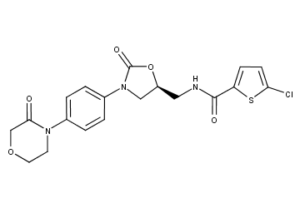Rivaroxaban CAS NO 366789-02-8 Inquire about Rivaroxaban
Tecoland supplies Rivaroxaban bulk active pharmaceutical ingredient (API) to the pharmaceutical industry. Our Rivaroxaban is manufactured by cGMP compliant facility. Welcome to contact us for further details including current DMF status for the product and up to date regulatory status of the manufacturing facility. We look forward to assisting you with your research and development projects.
What is Rivaroxaban?
Rivaroxaban (BAY 59-7939) is an oral anticoagulant invented and manufactured by Bayer; in a number of countries it is marketed as Xarelto. In the United States, it is marketed by Janssen Pharmaceutical. It is the first available orally active direct factor Xa inhibitor. Rivaroxaban is well absorbed from the gut and maximum inhibition of factor Xa occurs four hours after a dose. The effects last 8¨C12 hours, but factor Xa activity does not return to normal within 24 hours so once-daily dosing is possible. There is no specific way to reverse the anticoagulant effect of rivaroxaban in the event of a major bleeding event, unlike warfarin.
Indication
Rivaroxaban is indicated for the prevention of venous thromboembolic events (VTE) in patients who have undergone total hips replacements and total knee replacement surgery. Due to a lack of safety studies, it is not recommended for use in those under 18 years old. Its use is also not recommended in those with severe renal impairment (<30mL/min).
What is the mechanism of action?
Rivaroxaban is an oxazolidinone derivative optimized for inhibiting both free Factor Xa and Factor Xa bound in the prothrombinase complex. It is a highly selective direct Factor Xa inhibitor with oral bioavailability and rapid onset of action. Inhibition of Factor Xa interrupts the intrinsic and extrinsic pathway of the blood coagulation cascade, inhibiting both thrombin formation and development of thrombi. Rivaroxaban does not inhibit thrombin (activated Factor II), and no effects on platelets have been demonstrated.
Rivaroxaban has predictable pharmacokinetics across a wide spectrum of patients (age, gender, weight, race) and has a flat dose response across an eightfold dose range (5¨C40 mg). Clinical trial data have shown that it allows predictable anticoagulation with no need for dose adjustments and routine coagulation monitoring. However, these trials have excluded patients with liver disease and end-stage liver disease; therefore, the safety of rivaroxaban in these populations is unknown.
Pharmacodynamics
Rivaroxaban is an anticoagulant which binds directly to factor Xa. Thereafter, it effectively blocks the amplification of the coagulation cascade, preventing the formation of thrombus. Rivaroxaban is an unique anticoagulant for two reasons. First of all, it is does not involve antithrombin III (ATIII) to exert its anticoagulant effects. Secondly, it is an oral agent whereas the widely used unfractionated heparin and low molecular weight heparins are for parenteral use only. Although the activated partial thromboplastin time (aPTT) and HepTest (a test developed to assay low molecular weight heparins) are prolonged in a dose-dependent manner, neither test is recommended for the assessment of the pharmacodynamic effects of rivaroxaban. Anti-Xa activity and inhibition of anti-Xa activity monitoring is also not recommended despite being influenced by rivaroxaban.
How to dose Rivaroxaban?
Rivaroxaban comes as a tablet to take by mouth. It is usually taken once a day. The first dose should be taken at least 6 to 10 hours after surgery. Rivaroxaban can be taken with or without food, unless you are told specifically to take it with food by your doctor or pharmacist. When rivaroxaban is taken after hip replacement surgery, it is usually taken for 35 days. When rivaroxaban is taken after knee replacement surgery, it is usually taken for 12 days. Take rivaroxaban at around the same time every day. Follow the directions on your prescription label carefully, and ask your doctor or pharmacist to explain any part you do not understand. Take rivaroxaban exactly as directed.
What are the side effects of Rivaroxaban?
Rivaroxaban may cause side effects. Tell your doctor if any of these symptoms are severe or do not go away:
- itching
- muscle spasm
Some side effects can be serious. If you experience any of these symptoms, call your doctor immediately:
- bloody, black, or tarry stools
- blood in urine
- coughing up or vomiting blood or material that looks like coffee grounds
- nosebleeds
- bleeding from your gums
- weakness
- tiredness
- dizziness or fainting
- blurred vision
- pain in arm or leg
Rivaroxaban prevents blood from clotting normally so it may take longer than usual for you to stop bleeding if you are cut or injured. This medication may also cause you to bruise or bleed more easily. Call your doctor right away if bleeding or bruising is unusual.
Toxicity
Excessive bleeding. Overdosages should be treated using activated charcoal and supportive measures such as mechanical compression and hemodynamic support. If bleeding is not controlled, the following procoagulants can be administered: activated prothrombin complex concentrate, prothrombin complex concentrate and recombinant factor VIIa. There is also a higher chance of post procedural hemorrhage compared to enoxaparin (1.55% vs. 1.39% respectively).
Disclaimer:
Information on this page is provided for general information purposes. You should not make a clinical treatment decision based on information contained in this page without consulting other references including the package insert of the drug, textbooks and where relevant, expert opinion. We cannot be held responsible for any errors you make in administering drugs mentioned on this page, nor for use of any erroneous information contained on this page.